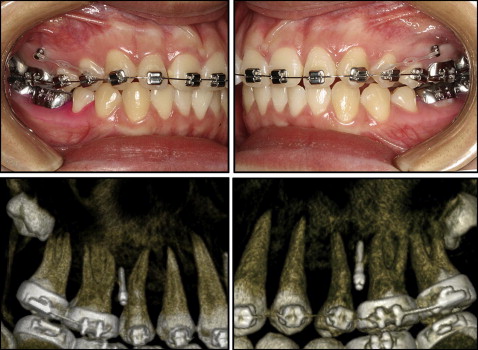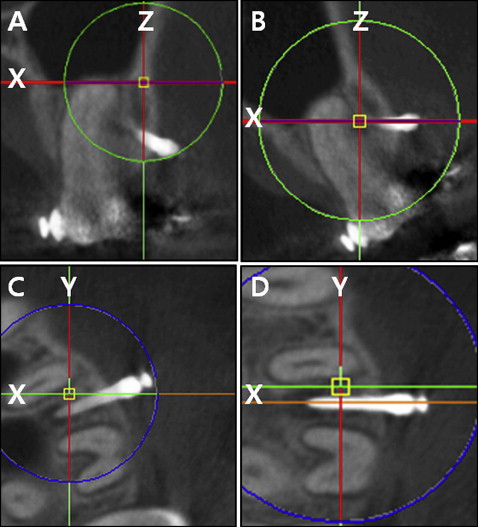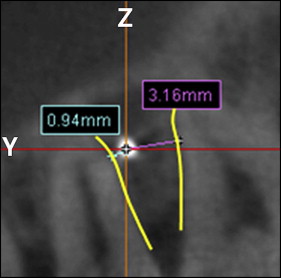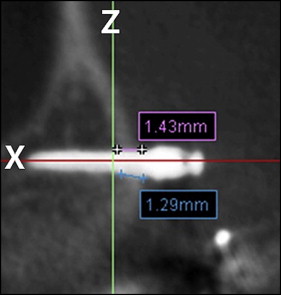Introduction
The purpose of this study was to evaluate the effect of placement angles on the success rate of orthodontic microimplants and other factors with cone-beam computed tomography images.
Methods
We examined 228 orthodontic microimplants implanted into the maxillary buccal alveolar bone of 130 patients (33 men, 97 women) with malocclusion. Vertical placement angle, horizontal placement angle, root proximity, and cortical bone thickness were measured, and the correlations between these measurements and orthodontic microimplant success rates and the correlations among the measurements were evaluated.
Results
The overall success rate was 87.7% (200 of 228). The orthodontic microimplant success rate statistically significantly increased as root proximity (distance from the orthodontic microimplant to the root surface) increased ( P <0.05), but there were no statistical significances between placement angles and success rates, and cortical bone thickness and success rate ( P >0.05). Correlations between placement angles and root proximity showed no statistical significance ( P >0.05), but correlations between vertical placement angle and cortical bone thickness ( P <0.001) and between horizontal placement angle and cortical bone thickness ( P <0.01) showed statistical significance. A statistically significant (negative) correlation was found between vertical and horizontal placement angles ( P <0.001).
Conclusions
The success rate of orthodontic microimplants is not affected by placement angles and is more significantly affected by root proximity than by cortical bone thickness. Cortical bone thickness is affected by placement angles, but root proximity is not affected by placement angles.
Anchorage is the cornerstone of the orthodontic force system. Various techniques to reinforce anchorage have been devised and used in orthodontic practice. For over a decade, orthodontists have been able to achieve absolute anchorage with bony anchorage techniques, which are now widely used. Compared with other methods of bony anchorage, orthodontic microimplants have been hailed as particularly efficient for orthodontic treatment, having advantages such as a wide variety of application areas, reduced need for patient cooperation, and fewer side effects on teeth. As the frequency of orthodontic microimplant use increases, clinicians are becoming more concerned about the factors affecting their success rates.
The success rates of orthodontic microimplants have been reported differently because of several variables. In addition, many studies have recently been performed to determine factors affecting their success rates. Among them, root proximity to the orthodontic implant, cortical bone thickness, and placement angle have been reported frequently.
Kuroda et al concluded that the proximity of a miniscrew to the root was a major risk factor for failure of the screw. Min et al also reported that increasing the distance from the orthodontic microimplant to the root surface would significantly improve the success rate. In contrast, Kim et al reported that the amount of root contact area of a mini-implant was more important for its stability than root proximity. Park and Cho suggested that the interradicular spaces between the second premolar and the first molar in the maxillary buccal alveolar bone were adequate and safe locations for placing orthodontic microimplants.
Baumgaertel and Hans suggested that knowledge of the pattern of variation in cortical bone thickness and its mean values could aid in mini-implant site selection and preparation, but future studies are needed to determine the exact relationship between cortical bone thickness, the method of implant site preparation, and success rates.
Deguchi et al suggested that angling the implant at approximately 30° would increase the contact with the cortical bone by as much as 1.5 times more than placing implants perpendicular to the long axis of the tooth. Lim et al also suggested that placing mini-implants at 30° or 45° from the long axis of the tooth would increase the contact with the cortical bone. But El-Beialy et al reported that the vertical angle of placement of miniscrews with the buccal alveolar plate measured on the 3-dimensional (3D) volume did not determine their success.
Many studies have also investigated factors affecting the success rate of orthodontic microimplants by using 3D computed tomography imaging, in addition to 2-dimensional (2D) radiography. Recently, cone-beam computed tomography (CBCT) has been widely used in orthodontics to reduce the shortcomings of conventional computed tomography such as radiation dosage, cost, and device size. However, there are few clinical reports of CBCT imaging analysis of orthodontic microimplants implanted in patients for orthodontic anchorage, especially for placement angles. Therefore, in this study, vertical and horizontal placement angles, root proximity, and cortical bone thickness were measured by using CBCT imaging to evaluate the correlations between the measurements and the orthodontic microimplant success rates, and among the placement angles and other factors.
Material and methods
Before this study, a power analysis with G*Power (version 3.1.3; Franz Faul, Christian-Albrechts-Universität, Kiel, Germany) was performed to estimate the sample size. The sample size for the study was calculated based on a significance level of 0.05 and a power of 85%. The power analysis showed that 128 patients were required. Institutional review board approval was granted by the Wonkwang University Dental Hospital (number WKD IRB 20111201) of Iksan, Korea, to conduct this study.
The sample consisted of CBCT images of 130 consecutive patients (33 male, 97 female; mean age, 19.24 years; SD, 6.66 years) who received orthodontic microimplants in the maxillary buccal alveolar bone for orthodontic anchorage by 3 right-handed operators at the Department of Orthodontics, Wonkwang University Daejeon Hospital, in Daejeon, Korea, from January 2008 to November 2010 ( Table I ). Before implantation, the patients were informed of the advantages and disadvantages of this procedure, and informed consent was obtained from all of them. We also evaluated the range of bone availability at interradicular locations using panoramic radiographs. The patients agreed to have CBCT scans after placement of the orthodontic microimplants into the maxillary buccal alveolar bone. The images were taken with a CBCT device (PSR 9000N; Asahi Alphard Vega, Kyoto, Japan) with dosimetry parameters of 12 mA, 80 kV, and a 17-second scan time on a dental mode (D mode; scan size, 51 × 51 mm; voxel size, 0.1 mm).
| Sex | Number | Mean age ± SD (y) |
|---|---|---|
| Male | 33 | 17.55 ± 5.18 |
| Female | 97 | 19.78 ± 7.00 |
| Total | 130 | 19.24 ± 6.66 |
The CBCT data were saved as digital imaging and communications in medicine (DICOM) files, and Simplant CMF software (version 13; Materialise NV, Leuven, Belgium) was used for analysis of the DICOM data to generate quantitative measurements.
We examined 228 orthodontic microimplants (1.2-1.3 mm in diameter, tapered type, 8 mm in length; implant type: AbsoAnchor SH1312-08 [self-drilling style, tapered type], Dentos, Taegu, Korea) implanted into the maxillary buccal alveolar bone. All orthodontic microimplants were placed directly with a hand driver, according to the self-drilling procedure, at the Department of Orthodontics, Wonkwang University Daejeon Dental Hospital, with patients under local anesthesia. The orthodontic microimplants were inserted into the attached gingiva just adjacent to the mucogingival junction, the midpoint between the roots of the adjacent teeth, and immediately loaded with orthodontic forces of about 50 to 200 g with elastic chains ( Fig 1 ).

Orthodontic microimplants that were maintained in the bone and acted as an appropriate anchorage unit for over 1 year under orthodontic force during treatment were considered successful. Success rates according to age, sex, side of placement (right or left), and the overall success rate were calculated. To assess the effect of age on the success rate, the patients were divided into 2 groups according to age: young patients (<20 years of age) with 137 orthodontic microimplants and adults (20 years of age or older) with 91 orthodontic microimplants ( Table II ).
| Success rates (%) | Success/total orthodontic microimplant | Significance (chi-square test) | |
|---|---|---|---|
| Sex | 0.641 (0.277) | ||
| Male | 85.7 | 48/56 | |
| Female | 88.4 | 152/172 | |
| Age (y) | 0.101 (2.960) | ||
| <20 | 84.7 | 116/137 | |
| ≥20 | 92.3 | 84/91 | |
| Side of placement | 0.225 (1.987) | ||
| Right | 84.5 | 93/110 | |
| Left | 90.7 | 107/118 | |
| Total | 87.7 | 200/228 | |
For measurements, the orthodontic microimplant’s long axis was corresponded to the axial plane in the coronal view ( Fig 2 , A and B ). Then, it was corresponded to the coronal plane in the axial view ( Fig 2 , C and D ). When the image is reoriented by using the Simplant software in this way, the full long axis of the orthodontic microimplant can be seen in the coronal and axial views, and it is seen as a circular shape in the sagittal view ( Fig 3 ).


Vertical and horizontal placement angles were determined by measuring the occlusal and mesial angles between the bone surface and the orthodontic microimplant’s long axis on the reoriented coronal and axial views of the CBCT images, respectively. Bone surfaces were defined as a line drawn by connecting 2 points that are intersecting points made by the orthodontic microimplant and the outer cortical bone on the coronal and axial views, respectively ( Figs 4 and 5 ).


Root proximity to the orthodontic microimplant was determined by measuring the shortest distance between the root surface and the center of the orthodontic microimplant on the sagittal view of the CBCT image ( Fig 6 ). We selected the value in which the mean radius of the orthodontic microimplant (0.625 mm) was subtracted from the shortest distance between the root surface and the microimplant’s center. Cortical bone thickness was measured on the coronal view of the CBCT image as the depth of the cortical bone contacting the orthodontic microimplant. We selected an average of 2 measurements of cortical bone thickness in contact with the orthodontic microimplant ( Fig 7 ).


Statistical analysis
To test the reliability of the measurements, 1 investigator (Y.-R.J.) randomly selected 20 subjects for duplicate measurements 2 weeks after the initial measurements; this showed no statistically significant differences ( P >0.05) in the intraclass correlation coefficient (ICC). The ICC showed excellent test-retest reliability of the 3D measurements of orthodontic microimplants at the 95% confidence interval: 0.925 for vertical placement angle, 0.938 for horizontal placement angle, 0.970 for root proximity, and 0.907 for cortical bone thickness.
Descriptive statistics were initially performed to calculate the overall success rate of the orthodontic microimplants, as well as their specific success rates with regard to the patients’ age, sex, and placement side, and for vertical and horizontal placement angles, root proximity, and cortical bone thickness. All values recorded in this study are presented as means and standard deviations. Logistic regression multivariate analysis was used to examine the correlations between success rates and age, sex, and placement side (right or left). SPSS software (version 18.0; SPSS, Chicago, Ill) was used for all statistical calculations. Logistic regression analysis was carried out to evaluate the correlations between measurements (vertical and horizontal placement angles, root proximity, and cortical bone thickness) and success rates. The Wald test was also used to test the true value of the measurements on the success rates. The Pearson correlation coefficient of variables among placement angles and other factors (root proximity and cortical bone thickness) was carried out. The statistical significance was set at P <0.05 for all tests.
Results
The overall success rate was 87.7% (200 of 228 orthodontic microimplants). All 228 orthodontic microimplants were inserted into maxillary buccal alveolar bone: 110 were placed on the right side and 118 on the left side. Placement side was related to success rate: the right-side success rate was 84.5% (93 of 110), and the left-side success rate was 90.7% (107 of 118). Age was also related to success rate: in young patients (<20 years), the success rate was 84.7% (116 of 137 orthodontic microimplants), and in adult patients (≥20 years), the success rate was 92.3% (84 of 91). Finally, sex was related to success rate. The success rates were 85.7% (48 of 56 orthodontic microimplants) in male patients and 88.4% (152 of 172) in female patients. Thus, the success rates were higher in the left side than in the right side, in adults than in younger patients, and in female subjects than in male subjects, although these trends were not statistically significant ( Table II ).
Table III shows the values and standard deviations of the placement angles, root proximity, and cortical bone thickness according to success or failure of the orthodontic microimplants. The mean values of vertical placement angle, horizontal placement angle, root proximity, and cortical bone thickness in the success and failure groups were 73.75° and 75.93°, 97.11° and 96.65°, 0.49 and 0.11 mm, and 1.17 and 0.97 mm, respectively.



